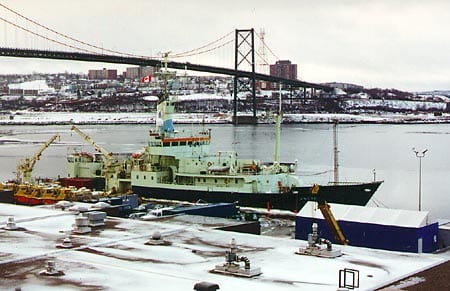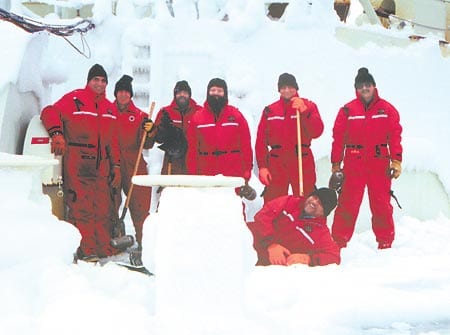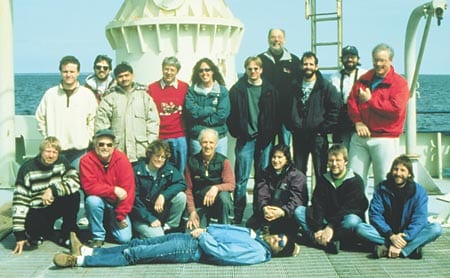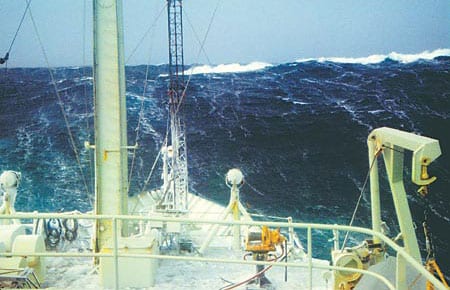
A Northern Winter
Preparing R/V Knorr for the North Atlantic and Labrador Sea
As the 1996-1997 ship schedule began to take shape in 1995, we learned that Voyage 147 would take R/V Knorr into the North Atlantic from October ’96 through March of ’97. The various science missions would require station keeping during CTD casts, deployment of current drifters, and expendable bathythermograph (XBT) launches, as well as weather system analysis designed to put Knorr in the path of the harshest weather conditions possible during the winter season. Long before the cruise, we began to tap all available assets that would help us with this challenge.
We were especially fortunate to benefit from the experience of Captain Robertson P. Dinsmore, retired manager of WHOI Marine Operations and also former US Coast Guard weather ship program manager. During a meeting in early October, prior to departure on the first leg of the cruise, Captain Dinsmore detailed his own experiences in the North Atlantic, and provided a wealth of information on ice accretion as well as movement of pack ice and icebergs throughout the changing seasons.
We also contacted the National Ice Center and the Canadian Ice Service by phone and selected a series of ice maps to be sent to the ship on a weekly update schedule. These ranged from charts showing the location of known icebergs to a map delineating the extent of all known ice as well as the edge of “sea ice.”
The physical resources we assembled included such basics as hats and gloves, insulated work suits, shovels, and sand. We also began a search for what would become our next best friend—the ice mallet.
A real danger of working at sea in winter conditions is freezing spray. Given sufficiently cold temperatures, the spray that we might enjoy on a summer day instead becomes a threat to the vessel as it freezes on contact and grows in size and weight with blowing spray from each new crashing wave. In the most severe case, the ship’s stability could be affected. Then there are two options: Head for warmer waters, or manually knock the ice off the ship.
While still in Woods Hole we attempted an exchange for all of WHOI’s old softball bats. This didn’t provide the number needed, so we continued our search in our next ports of call, the Azores islands, and Southampton, England. However, it wasn’t until we arrived in Halifax, Nova Scotia, that we found just what we where looking for: The “ice mallet” is of stout wood construction including a head of sycamore (a wood with interlocking grain). We wielded the mallets frequently during the Labrador Sea work to break up ice that had formed on deck so we could shovel it overboard. This was grueling work! For example, on February 18 at 60°N, 52°39’W, a dozen crew members worked morning and afternoon to remove an estimated 30,000 pounds of ice. This is the rough equivalent of having two extra container vans on deck—and it was discouraging to see how fast the ice could build back up.
Mental preparation for the wintertime North Atlantic was also very important. Both crew and scientists would be subjected time and time again to both bitter cold and long work hours. Extra lookouts were needed while in the vicinity of ice. Fortunately, spirits were generally good, and scientists as well as crew turned to when it became necessary to use the shovels and ice mallets to remove ice from the ship.
Safety, always emphasized, became ever so much more important! We focused on the necessity for good communication during every phase of each operation. Are you going out on deck? Wear the proper clothing and flotation. Notify the bridge and science lab. Operation completed? Notify the bridge when all personnel are back inside. Due to the extreme conditions, science operations that had become old hat during our many World Ocean Circulation Experiment (WOCE) cruises received more scrutiny, and some adjustments were made to protect personnel.
The importance of these concerns was driven home one morning in December. Knorr received a distress call from a fishing vessel just six miles away. A man had been lost overboard while deploying gear. We joined the search, and a search and rescue helicopter was sent from Shannon, Ireland. When the helicopter ran low on fuel, Knorr was named as “on-scene coordinator” until the search was called off hours later by the Regional Command Center in Dublin. Waters this frigid draw life away in a matter of seconds. The fisherman was never found. I believe most of us felt the loss on board that vessel, and redoubled our efforts to make sure we avoided a similar fate.
Our general plan was to work to Knorr’s strengths. With the hydro boom located midships on the starboard side, minimizing ship’s motion, and the starboard side hanger providing some protection for personnel, Knorr is particularly well suited for conductivity/temperature/depth (CTD) casts even as weather conditions start to deteriorate. By putting the wind to port, the starboard working deck is afforded a lee, and some CTD stations were completed as wind gusted 40 to 50 knots.
It also was our intention to avoid exposure to the pack ice as much as possible while making every effort to safely achieve science objectives. This proved difficult in the coastal regions of the Labrador sea. The end of every transect meant a close approach to pack ice in an effort to reach shallow water and complete data collection. We specifically planned to approach these regions at first light, do the best we could to work our way closer to the coast during daylight hours, and retreat before night fall.
Daylight hours are reduced that far north during winter. As a comparison, Mike McCartney’s November/December cruise was more problematic in that regard than Scripps Scientist Lynne Talley’s cruise that retraced the same track in May/June. Transit speeds along the southeast coast of Greenland were reduced for up to 14 hours a day in December due to darkness and concerns about ice in the area. In June, increased daylight allowed transit at full available speed for all but a few hours per day even though ice was still present.
Despite numerous obstacles, Knorr Voyage 147 is viewed as an unparalleled success. Preparation played a key role. The dedication and resourcefulness of the people aboard Knorr during those cruises put the voyage over the top. Their contributions were key to our success.
Arthur D. Colburn III is a second generation Atlantis captain. His father, Dick, was the last master of the first Atlantis and sailed on many other WHOI vessels during nearly 40 years with the Institution. A.D. graduated from Massachusetts Maritime Academy in 1978, having made part of his senior cruise as a cadet aboard Knorr. After working elsewhere in the maritime industry, he returned to WHOI as Atlantis II Third Mate in 1983, became the ship’s master upon completing his master’s license in 1995, and moved to Knorr when Atlantis II was retired in 1996.
Slideshow
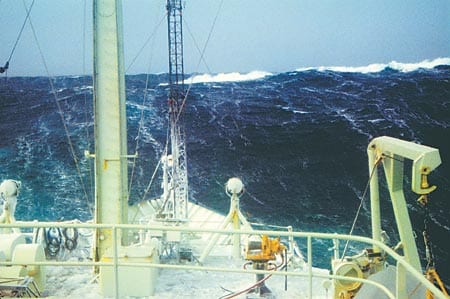
Slideshow
 The freezing wash of large Labrador Sea waves like this one resulted in the ice buildup pictured on previous pages.
The freezing wash of large Labrador Sea waves like this one resulted in the ice buildup pictured on previous pages.- Knorr is at pierside in Halifax for final Labrador Sea cruise preparations.
- Enthusiastic crew members pose for a picture before tackling the ice buildup on Knorr in the Labrador Sea. Author and ship captain A.D. Colburn is fourth from left
- Smiles abound on science party faces as Knorr Voyage 147, Leg V, nears home port, and the ice and cold temperatures become distant memories.

